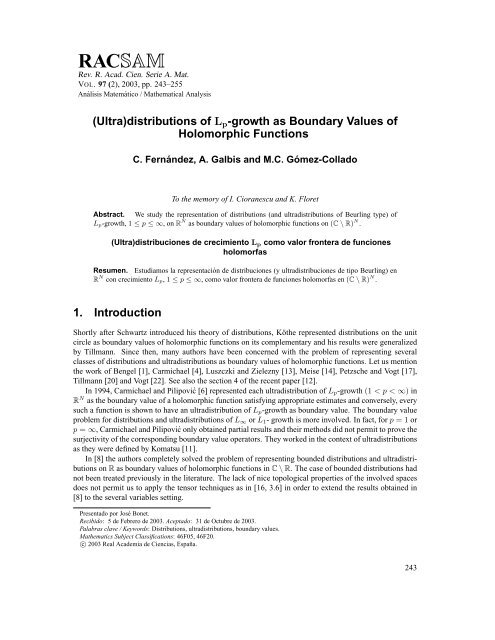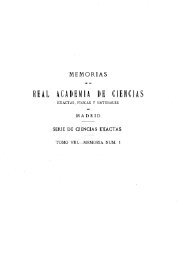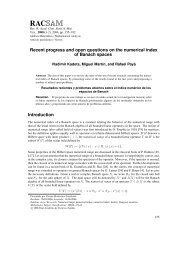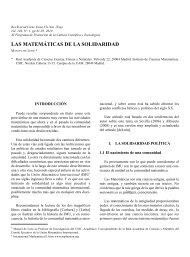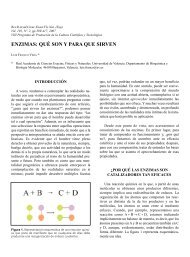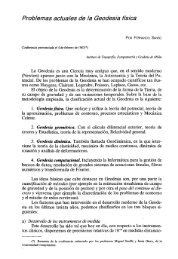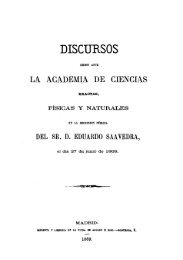Holomorphic Functions
Holomorphic Functions
Holomorphic Functions
You also want an ePaper? Increase the reach of your titles
YUMPU automatically turns print PDFs into web optimized ePapers that Google loves.
(Ultra)distributions of L p-growth as boundary values of holomorphic functionsThen D (ω) (K), endowed with its natural topology, is a Fréchet space. For a fundamental sequence (K j ) j∈Nof compact subsets of R N we letD (ω) (R N ) := indj→ D (ω)(K j ).The dual D ′ (ω) (RN ) of D (ω) (R N ) is endowed with its strong topology. The elements of D ′ (ω) (RN ) arecalled ultradistributions of Beurling type.We denote by E (ω) (R N ) the set of all functions f ∈ C ∞ (R N ) such that ‖ f ‖ K,λ < ∞ for every compactK in R N and for every λ > 0.Definition 3 ([2]) For every 1 ≤ p ≤ ∞, k ∈ N and φ ∈ C ∞ (R N ), γ k,p (φ) is defined as follows( ( )) |α|γ k,p (φ) = sup ‖φ (α) ‖ p exp −kϕ ∗ ,α∈N kN0where ‖.‖ p denotes the usual norm in L p (R N ).If 1 ≤ p < ∞ the space D Lp,(ω)(R N ) is the set of all C ∞ -functions φ on R N such that γ k,p (φ) < ∞for each k ∈ N. A function φ ∈ C ∞ (R N ) is in B L∞,(ω)(R N ) when γ k,∞ (φ) < ∞, for every k ∈ N. Wedenote by D L∞,(ω)(R N ) the subspace of B L∞,(ω)(R N ) consisting of those functions φ ∈ B L∞,(ω)(R N ) forwhich lim|x|→∞ |φ(α) (x)| = 0 for each α ∈ N N 0 .The topology of D Lp,(ω)(R N ), 1 ≤ p ≤ ∞, is generated by the family of seminorms {γ k,p } k∈N . Also, weconsider on B L∞,(ω)(R N ) the topology associated with {γ k,∞ } k∈N . Then D Lp,(ω)(R N ), 1 ≤ p ≤ ∞ andB L∞,(ω)(R N ) are Fréchet spaces.For the definition of the spaces D Lp (R N ), 1 ≤ p ≤ ∞, we refer to [19, VI,8].Remark 2 (a) Clearly D Lp,(ω)(R N ) is continuously contained in D Lp (R N ), 1 ≤ p ≤ ∞. Hence, ifφ ∈ D Lp,(ω)(R N ), 1 ≤ p ≤ ∞, then lim|x|→∞ |φ(α) (x)| = 0, for each α ∈ N N 0 .(b) The inclusions D (ω) (R N ) ⊂ D Lp,(ω)(R N ) ⊂ E (ω) (R N ) are continuous and dense, and for 1 ≤ p ≤q ≤ ∞, D Lp,(ω)(R N ) is continuously contained in D Lq,(ω)(R N ).(c) Although the paper [2] was written in the one variable setting, all the results in its section 2 also holdfor N > 1 with the same proofs. The dual of D Lp,(ω)(R N ) will be denoted by (D Lp,(ω)(R N )) ′ and it will be endowed with the strongtopology. Since D (ω) (R N ) is continuously and densely embedded in D Lp,(ω)(R N ) then (D Lp,(ω)(R N )) ′can be identified with a subspace of D ′ (ω) (RN ). The elements of (D Lp,(ω)(R N )) ′ are known as ultradistributionsof Beurling type of L p ′-growth where p ′ is the conjugate exponent of p. The ultradistributions ofL ∞ -growth are called bounded ultradistributions of Beurling type.The classical case D Lp (R N ) is formally not a particular case of what we present here since ω(t) =log(1 + t) does not satisfy property (γ). However, all our results also hold in this case after minor modifications.Let G ∈ H(C N ) be an entire function such that log |G(z)| = O(ω(|z|)) as |z| tends to infinity. ThenT G (ϕ) := ∑α∈N N 0defines an ultradistribution T G ∈ E ′ (ω) (RN ). The operator(−i) |α| G(α) (0)ϕ (α) (0)α!G(D) : D ′ (ω) (RN ) → D ′ (ω) (RN ),G(D)ν := T G ∗ ν245
(Ultra)distributions of L p-growth as boundary values of holomorphic functionsRemark 3 For ω(t) = log(1 + t), t ≥ 0, we have that ω ∗ (s) = 0 for s ≥ 1 while ω ∗ (s) = s − log(es)whenever 0 < s < 1. Therefore, it is easy to see that in this case HpN := Hω N ∗ ,p can be described asH N p = {f ∈ H((C \ R) N ) : |f| p,k < ∞ for some k ∈ N}where|f| p,k := supy⎛ ⎞N∏‖ f(· + iy) ‖ p e −2k|y| ⎝ |y j | ⎠j=1k. For any weight ω, HpN ⊂ Hω N ∗ ,p and given two weights σ ≤ ω we have Hσ N ∗ ,p ⊂ Hω N ∗ ,p with continuousinclusions.Since we can represent (ultra)distributions of L p -growth as a (infinite) linear combination of derivativesof functions in L p , we will show that the spaces just defined are stable under (ultra)differential operators.Lemma 1 (1) For each f ∈ H N p and each α ∈ N N 0 we have f (α) ∈ H N p .(2) For each f ∈ H N ω ∗ ,p and each ultradifferential operator G(D) of class (ω) we have G(D)f ∈ H N ω ∗ ,p.PROOF. Let f ∈ H ω ∗ ,p(R N ) be given. We fix y ∈ R N such that y j ≠ 0 for every 1 ≤ j ≤ N and we putρ j := 1 2 |y j|. Let D ρ be the polidisc of poliradius ρ := (ρ 1 , . . . , ρ N ). For each x ∈ R N and each α ∈ N N 0 ,by the Cauchy integral formulaf (α) (x + iy) = α! ∫f(x + iy + ξ)(2πi) N D ρξ α+1 dξ.The function g ξ (x) :=Thereforef(x + iy + ξ)ξ α+1belongs to L p (R N ) andf (α) (· + iy) = α!(2πi) N ∫‖ f (α) (· + iy) ‖ p ≤ α!(2π) ND ρg ξ (·) dξ.maxξ∈D ρ‖ g ξ ‖ pSince ‖ g ξ ‖ p ≤ 1ρ α+1 |f| ω,p,k e 2k|y|+kω∗ ( y2k ) for some constant k ∈ N,‖ f (α) (· + iy) ‖ p ≤ |f| ω,p,k α! e 2k|y|+kω∗ ( y2k )N∏j=1N∏j=1(2πρ j ).( ) αj2.|y j |If ω(t) = log(1 + t) (t ≥ 0) this gives (1). To show (2), let G(D) be an ultradifferential operator of class(ω). Then G(D)g = ∑a α g α where |a α | ≤ Ce −mϕ∗ ( |α|m ) ≤ Ce −m ∑ Nj=1 ϕ∗ ( α jm ) for some C > 0 andsome m ∈ N. Thusα∈N N 0‖ G(D)f(· + iy) ‖ p≤ ∑|a α | ‖ f (α) (· + iy) ‖ pα∈N N 0≤ C|f| ω,p,k∑α∈N N 0α!N∏j=1( ) αj−mϕ 2∗ ( α jm ) e 2k|y|+kω∗ ( y2k ) .|y j |247
C. Fernández, A. Galbis, M.C. Gómez-ColladoThat is,‖ G(D)f(· + iy) ‖ p ≤ C |f| ω,p,kN ∏⎛⎝∞∑j=1 α j=0To finish it is enough to proceed as in [8, Prop.1].⎞( ) αjα j ! e −mϕ∗ ( α j 2m ) |y j |( |yj⎠ e 2k|yj|+kω∗ |2k).It is clear now that, given f ∈ HpN and y ∈ R N , y j ≠ 0 for 1 ≤ j ≤ N, the function f(· + iy) belongsto D Lp (R N ) for 1 ≤ p < ∞ and f(· + iy) ∈ B L∞ (R N ) for p = ∞. A similar result holds for arbitraryweight functions ω.Corollary 1 (1) For every 1 ≤ p < ∞ and each f ∈ H N ω ∗ ,p we have f(· + iy) ∈ D Lp,(ω)(R N ).(2) Each f ∈ H N ω ∗ ,∞ satisfies f(· + iy) ∈ B L∞,(ω)(R N ).PROOF. Let 1 ≤ p ≤ ∞ and f ∈ Hω N ∗ ,p be given. Then G(D)f(. + iy) ∈ L p (R N ) for every ultradifferentialoperator G(D) of (ω)−class. Now it is enough to apply [2, Corollary 2.2] to conclude. Now, it is easy to show that the spaces H N ω ∗ ,p increase with p.Corollary 2 For a fixed function ω and p < q we have H N ω ∗ ,p ⊂ H N ω ∗ ,q with continuous inclusion.PROOF. Since D Lp,(ω)(R N ) ⊂ D Lq,(ω)(R N ) ⊂ B L∞,(ω)(R N ) with continuous inclusions ([2]), we deducefrom Corollary 1 that for every f ∈ Hω N ∗ ,p there is a continuous seminorm γ on D Lp,(ω)(R N ) suchthat ||f(. + iy)|| q ≤ γ(f(. + iy)) for every y ∈ R N with y j ≠ 0 for 1 ≤ j ≤ N. Hence there is anultradifferential operator G(D) of (ω)−class and there is a positive constant C satisfying||f(. + iy)|| q ≤ C||G(D)f(. + iy)|| pfor all y ∈ R N with y j ≠ 0 for all 1 ≤ j ≤ N ([2, 2.0.4]). Since G(D)f ∈ Hω N ∗ ,p then it easily followsthat f ∈ Hω N ,q. ∗4. Boundary valuesIn this section we will show that each function in Hω N ∗ ,p has an element of (D Lp ′ ,(ω)(R N )) ′ , 1 p + 1 p= 1, as′boundary value and that, conversely, each (ultra)distribution of L p -growth can be obtained as the boundaryvalue of a suitable f in Hω N ,p. From now on ω will be either a weight function satisfying (α ∗ 1 ) or ω(t) =log(1 + t), t ≥ 0.We first observe that each f ∈ H N ω ∗ ,p belongs to H N ω ∗ ,∞ and, after applying [22] for ω(t) = log(1 + t)and [17] for ω a weight function satisfying (α 1 ), we have the following resultLemma 2 The boundary value operator T : H N ω ∗ ,p → D ′ (ω) (RN ) given by∫< T (f), ϕ >:= lim {ɛ→0 + R N∑(σ∈{−1,1} N j=1N∏σ j )f(x + iσɛ)} ϕ(x) dxis a well-defined, continuous and linear mapping. Moreover T (f) ∈ (D L1,(ω)(R N )) ′ for each f ∈ H N ω ∗ ,∞and T is continuous as a map from H N ω ∗ ,∞ into (D L1,(ω)(R N )) ′ . Therefore T is also continuous from H N ω ∗ ,pinto (D L1,(ω)(R N )) ′ .248
(Ultra)distributions of L p-growth as boundary values of holomorphic functionsPROOF. In fact, T is nothing else but the restriction of the boundary value operator considered in [17] and[22]. Now it is enough to proceed as in the first part of the proof of Theorem 3 in [8]. Next, we show that the boundary value of a function in Hω N ∗ ,p is an (ultra)distribution of L p -growth.Proposition 1 T (H N ω ∗ ,p) is contained in (D Lp ′ ,(ω)(R N )) ′ with 1 p + 1 p ′= 1. Moreover,T (f) = lim∑(ɛ→0 +σ∈{−1,1} N j=1in the weak topology σ((D Lp ′ ,(ω)(R N )) ′ , D Lp ′ ,(ω)(R N )).N∏σ j )f(x + iσɛ)PROOF. First we assume that N = 1 and that ω is a weight function. Given f ∈ Hω 1 ∗ ,p we choose k ∈ Nand C > 0 such thatmax(‖ f(· + iy) ‖ ∞ , ‖ f(· + iy) ‖ p ) ≤ Ce kω∗ ( y k ) (1)for 0 < y < 2. Without loss of generality we may assume that f ≡ 0 in the lower half-plane. We willshow that {f(· + iɛ) : 0 < ɛ < 1} is a bounded set in (D Lp ′ ,(ω)(R)) ′ and that T (f) ∗ ϕ ∈ L p (R) forevery ϕ ∈ D (ω) (R). We put f iɛ (x) := f(x + iɛ). Let ϕ ∈ D (ω) (R) be given and let b > 0 be such thatsupp ϕ ⊂] − b, b[. By [17, 3.4] we find φ ∈ D((−b, b) × (− 1 2 , 1 2)) such that(i) φ |R = ϕ∣ (ii) sup∂∣∂¯z φ(x + iy) ( ∣∣∣ |y|ekω∗ k ) < ∞.z∈C\RApplying Stokes’ theorem to the function θ x (ξ) := f(ξ + iɛ)φ(x − ξ) in the rectangle D x := [x − 2b, x +2b] × [0, 1] we get that∫(f iɛ ∗ ϕ)(x) = 2i f(x − t + i(v + ɛ)) ∂ φ(t − iv) d(t, v).∂¯zDDwhere D := [−2b, 2b] × [0, 1]. Therefore∫∣ ∣ ∣∣∣ ∂ ∣∣∣‖ f iɛ ∗ ϕ ‖ p ≤ 2 ‖ f(· + i(v + ɛ)) ‖ p∂¯z φ(t − iv) d(t, v),from where we conclude that {f iɛ ∗ ϕ : 0 < ɛ < 1} is a bounded set in L p (R), which shows that {f iɛ :0 < ɛ < 1} is bounded in (D Lp ′ ,(ω)(R)) ′ ([2]), hence equicontinuos. Moreover, for every null sequenceof positive numbers (ɛ n ) n one has (T (f) ∗ ϕ)(x) = lim n (f iɛn ∗ ϕ)(x) pointwise and there is C > 0with |(f iɛn ∗ ϕ)(x)| ≤ C for every n ∈ N and each x ∈ R. Using Lebesgue’s dominated convergencetheorem we get that {(T (f) ∗ ϕ)χ [−n,n] : n ∈ N} is bounded in L p (R), hence T (f) ∗ ϕ ∈ L p (R)and T (f) ∈ (D Lp ′ ,(ω)(R)) ′ . Let us take a 0-neighbourhood V in D Lp ′ ,(ω)(R) such that T (f) ∈ V o andf iɛ ∈ V o for 0 < ɛ < 1 and let τ denote the topology of pointwise convergence on the dense subspaceD (ω) (R) of D Lp ′ ,(ω)(R). Then the weak topology and τ coincide on the equicontinuous set V o . Since< T (f), ϕ >= lim ɛ→0∫R f iɛ(x)ϕ(x)dx for every ϕ ∈ D (ω) (R) we get that T (f) is the limit of (f iɛ ) inthe weak topology.If ω(t) = log(1 + t), given ϕ ∈ D(R) we choose k ∈ N satisfying (1) and we putThen ∂φ∂¯z (x, y) = 1 2φ(x, y) :=k∑j=01j! ϕ(j) (x) (iy) j .ϕ (k+1) (x)(iy) k and we proceed as above. See [16, 2.2].k!249
C. Fernández, A. Galbis, M.C. Gómez-ColladoPROOF.Given σ ∈ {−1, 1} N , ɛ > 0 and ϕ ∈ D(R N ), one has that ˇf ∗ ϕ ∈ D Lp (R N ) and〈(S N (ψ) ∗ f)(· + iσɛ), ϕ〉 = 〈S N (ψ)(· + iσɛ), ˇf ∗ ϕ〉.Since S N (ψ) ∈ H1N ⊂ Hp N, ′ p′ being the conjugate number of p, it suffices to apply Proposition 1 forω(t) = log(1 + t) and Proposition 2. The following lemma permit us to get a similar result for p = ∞.Lemma 4 Let K be a compact set in R and let ψ ∈ D(K) be given. Then S 1 (ψ) ∈ H(C \ K) and, forsome positive constants A and C,|S 1 (ψ)(x ± iɛ)| ≤ C|x| 2whenever |x| ≥ A and 0 < ɛ < 1.PROOF. It is clear from the definition of S 1 . Proposition 4 Given Γ ∈ D(R N ) and f ∈ L ∞ (R N ) we have S N (Γ) ∗ f ∈ H N ∞ and T (S N (Γ) ∗ f) =Γ ∗ f.PROOF. We already know that S N (Γ) ∗ f ∈ H∞. N To see that T (S N (Γ) ∗ f) = Γ ∗ f we proceedin two steps. First, let K be a compact set in R and let ϕ 1 , . . . , ϕ N ∈ D(K) be given. We considerΓ := ϕ 1 ⊗ · · · ⊗ ϕ N and we put f j := S 1 (ϕ j ) ∈ H1. 1 Then F := S N (Γ) is given by F (z 1 , . . . , z N ) =∏ Nj=1 f j(z j ). Let us check that T (F ∗ f) = Γ ∗ f. We observe that⎛∑⎝σ∈{−1,1} NN∏j=1σ j⎞⎠ F (x + iσɛ) =N∏(f j (x j + iɛ) − f j (x j − iɛ)) .From Lemma 4, we choose ˜K a compact subset in R, K ⊂ ˜K, and C > 0 such thatj=1|f j (x j ± iɛ)| ≤ C|x| 2whenever x /∈ ˜K and 0 < ɛ < 1. Let η ∈ D(R) be identically one on a neighborhood of ˜K. For eachψ ∈ D(R N ) and each 0 < ɛ < 1 we have,〈(∑(σ∈{−1,1} N j=1N∏σ j )F (x + iσɛ)) ∗ f, ψ〉N∏= 〈 (f j (x j + iɛ) − f j (x j − iɛ)),j=1= I 1 (ɛ) + I 2 (ɛ) + I 3 (ɛ),N∏(1 − η(x j ) + η(x j ))( ˇf ∗ ψ)〉j=1whereN∏N∏I 1 (ɛ) := 〈 (f j (x j + iɛ) − f j (x j − iɛ)), ( η(x j ))( ˇf ∗ ψ)〉,j=1j=1N∏N∏I 2 (ɛ) := 〈 (f j (x j + iɛ) − f j (x j − iɛ)), (1 − η(x j ))( ˇf ∗ ψ)〉,j=1j=1252
(Ultra)distributions of L p-growth as boundary values of holomorphic functions[11] H. Komatsu. (1972). Ultradistributions I. Structure theorems a characterization, J. Fac. Sci. Univ. Tokyo, 20,25–105.[12] M. Langenbruch. (2003). A general approximation theorem of Whitney type, this volume.[13] Z. Luszczki and Z. Zielezny. (1961). Distributionen der Räume D ′ L pund Randverteilungen analytischer Funktionen,Colloq. Math., 8, 125–131.[14] R. Meise. (1977). Representation of distributions and ultradistributions by holomorphic functions, FunctionalAnalysis: Surveys and Recent Results, K. D: Bierstedt, R. Fuchssteiner (eds.) North Holland Pub. Co..[15] R. Meise and B.A. Taylor. (1988). Whitney’s extension theorem for ultradifferentiable functions of Beurling type,Ark. Mat. 26 (2), 265–287.[16] H.J. Petzsche. (1984). Generalized functions and the boundary values of holomorphic functions, J. Fac. Sci. Univ.Tokyo, Sect. IA, Math. 31, 391–431.[17] H.J. Petzsche and D. Vogt. (1984). Almost Analytic Extension of Ultradifferentiable <strong>Functions</strong> and the BoundaryValues of <strong>Holomorphic</strong> <strong>Functions</strong>, Math. Ann., 267, 17–35.[18] S. Pilipović. (1996). Elements of D ′ (M p)L s and {M p}D′ L s as Boundary Values of <strong>Holomorphic</strong> <strong>Functions</strong>, J. Math.Anal. Appl., 203, 719–737.[19] L. Schwartz. (1966). Theorie des distributions, Hermann, Paris, 1966.[20] H. G. Tillmann. (1953). Randverteilungen analytischer Funktionen und Distributionen, Math. Z., 59, 61–83.[21] H. G. Tillmann. (1961). Distributionen als Randverteilungen analytischer Funktionen II, Math. Z. ,77, 106–124.[22] D. Vogt. (1973). Distributionen auf dem R N als Randverteilungen holomorpher Funktionen, J. Reine Angew.Math., 261, 134–145.Carmen Fernández; Antonio GalbisM.Carmen Gómez-ColladoDepartamento de Análisis MatemáticoDepartamento de Matemática AplicadaUniversidad de ValenciaE.T.S. ArquitecturaDoctor Moliner 50Camino de VeraE-46100 Burjasot (Valencia), Spain E-46071 Valencia, Spainfernand@uv.es; Antonio.Galbis@uv.es cgomezc@mat.upv.es255


